
Cut-and-paste ... Untitled: For Angus - Film Still Collage I (2009), by John Stezaker. Image courtesy The Approach, London
With a few deft incisions with his scalpel, John Stezaker reveals what is lurking beyond the glossy surface of postcards and publicity stills. Sometimes one picture is simply positioned over the centre of another, but in a series such as Marriages (2006), men and women are forcibly yoked together with a swift, decisive incision down the middle. In Bridges, Stezaker's ongoing series started in the 1980s, buildings are chopped and reconfigured. Elsewhere the silhouette of a figure is cut out; its ghost-like absence filled in by more landscape or someone else's body. The technique is stunningly straightforward, the effect profound. As strong-jawed men are spliced with B-movie glamour pusses, bodily forms with architectural ones, painstakingly posed promo material becomes unruly, disorientating and freakish.
Stezaker soaked up a variety of influences while studying at London's Slade School of Fine Art in the 1960s. His teachers included Ernst Gombrich, an iconic art historian and Richard Wollheim, the Freudian philosopher. During this time, in France, the Situationist group of artists were arguing that reality had been replaced by the endless flow of images in the capitalist mass media. It was an idea Steazker took to heart, using the most straightforward kind of cut-and-paste to question the meaning of images.
Stezaker doesn't use just any picture: his raw materials are long-forgotten B-movie relics from British cinema, dating back to his childhood in the 1940s and 1950s, or retro picture postcards full of quaint grottos, waterfalls and terracotta roofs. Thanks to Stezaker's weird conjunctions, however, these images seem alienated – cut off from culture, place and time.
His technique has been constant since the 1970s, but success arrived later in life. The past decade has seen extensive solo shows in the US and Europe, and his inclusion in major survey shows such as the 2006 Tate Triennial. Perhaps this recognition has come about because his psychologically charged, modestly-scaled work seems ever more relevant in our technologically supercharged moment.
Why we like him: For Masks (2005), a series in which actors' faces are replaced with postcards of Romantic landscapes. A dark cave, gushing waterfall or train tunnel merges with a perfectly coiffed head. A man's brow slides into a motorway bridge; a craggy rock face stands in for eyes and nose. These are disturbing, dreamlike forms that burrow their way straight to our subconscious.
Poster child: A 1950s billboard advertising Start-Rite shoes introduced the young Stezaker to the hidden meaning of images. Its depiction of children seen from behind as they walk down the long road of life – seemingly towards their death – haunted his childhood.
http://www.guardian.co.uk/artanddesign/2010/jan/28/artist-of-week-john-stezaker
No comments:
Post a Comment